Columbidae • Psittacidae • Cuculidae • Tytonidae • Strigidae • Caprimulgidae • Apodidae • Trochilidae • Alcedinidae • Picidae
This list contains pictures of birds found on the official Louisiana Checklist. These birds were photographed within the state except where noted. Birds marked with an asterisk (*) are currently on the review list of the Louisiana Bird Records Committee.
ORDER COLUMBIFORMES
Family Columbidae: Pigeons and Doves
| |
Rock Dove (I) |
| |
Band-Tailed Pigeon* |
| |
Eurasian Collared Dove (I) |
| |
White-Winged Dove |
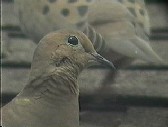
|
Mourning Dove |
| |
Passenger Pigeon* |
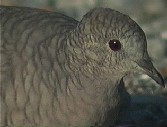
|
Inca Dove |
| |
Common Ground-Dove |
ORDER PSITTACIFORMES
Family Psittacidae: Parrots
ORDER CUCULIFORMES
Family Cuculidae: Cuckoos, Roadrunners, and Anis
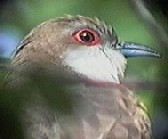
|
Black-Billed Cuckoo
Black-billed Cuckoos are uncommon spring and fall migrants through the state, more common (or at least better detected) some years than others. The red orbital ring, bluish bill with a black base, small white tips to the tail feathers, and lack of a rufous flash in the primaries in flight are diagnostic points in separating this bird from Yellow-billed Cuckoo. As cuckoos are secretive, often only one of these features will be apparent, but for the most part, any one is usually sufficient. However, I have seen juvenile Yellow-billeds that show a completely dark bill. There is at least one documented breeding record of this species for the state, from the Atchafalaya Basin. In addition, a rehabber in Lafayette raised a brood of Black-billeds in a nest that was left on her doorstep. The origin of the nest is unknown. |
| |
Yellow-Billed Cuckoo |
| |
Greater Roadrunner |
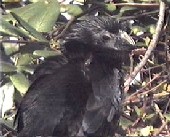
|
Groove-Billed Ani |
ORDER STRIGIFORMES
Family Tytonidae: Barn Owls

|
Barn Owl |
Family Strigidae: Typical Owls
| |
Flammulated Owl* |
| |
Eastern Screech-Owl |
| |
Great Horned Owl |
| |
Snowy Owl* |
| |
Burrowing Owl |
| |
Barred Owl |
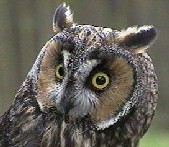
|
Long-Eared Owl |
| |
Short-Eared Owl |
| |
Northern Saw-Whet Owl* |
ORDER CAPRIMULGIFORMES
Family Caprimulgidae: Goatsuckers
| |
Lesser Nighthawk* |
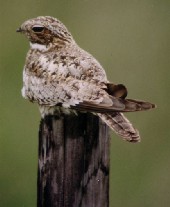
|
Common Nighthawk |
| |
Antillean Nighthawk |
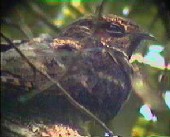
|
Chuck-Will's Widow |
| |
Whip-Poor-Will |
ORDER APODIFORMES
Family Apodidae: Swift
| |
Chimney Swift |
| |
Vaux's Swift* |
Family Trochilidae: Hummingbirds
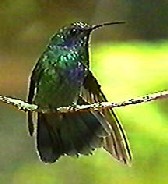
|
Green Violetear*
Although its range extends from Mexico south into South America, the Green Violet-ear has not been recorded as a breeder in the United States. Nonetheless, rarely a year goes by without multiple sightings in widely scattered locales in the eastern U.S, and even Canada. As a vagrant, this species is most expected in the hill country of central Texas. Elsewhere, the species is pretty much a "lottery bird". |
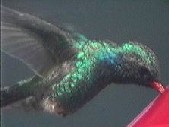
|
Broad-Billed Hummingbird*
Identification of Broad-billed Hummingbirds would hardly seem to be a problem. Adult males are so wildly colorful that the only real problem is singling out a field mark. One of the better features to key in on is the reddish bill, a character shared by few other hummers in the U.S. The dark forked tail separated from the dark belly by white undertail coverts creates a pattern that is another excellent point of separation from most other U.S. hummers. The final clue becomes obvious when the sunlight hits: the sparkling blue gorget glows against the rich dark green of the upperparts and belly. |
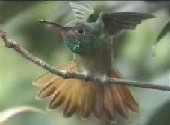
|
Buff-Bellied Hummingbird
The breeding range of the Buff-Bellied Hummingbird barely reaches the U.S. along the Lower Rio Grande Valley in Texas. However, the wintering range of the species takes in most of the western and northern U.S. Gulf Coast. Along the Gulf Coast in winter, identification is usually not much of a problem. Very few hummers can be mistaken for a Buff-bellied. |
| |
Blue-Throated Hummingbird |
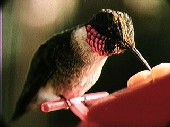
|
Ruby-Throated Hummingbird
Ruby-throats are of course the most common hummers in Louisiana, at least from March to October. They arrive in early March and are mostly gone by the last week of October. A very few overwinter. |
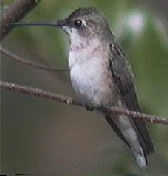
|
Black-Chinned Hummingbird |
| |
Anna's Hummingbird* |
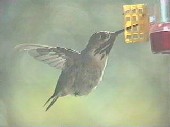
|
Calliope Hummingbird
Although the calliope is the smallest of u.s. hummers, size alone is a hard quality to judge in a group of birds known for being diminutive. the calliope, however, is small not only in overall size, but also in its individual parts: its bill, and especially its tail are noticeably short relative to those of our other hummers. nonetheless, calliope can easily be confused with many other hummers. |
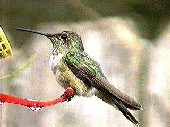
|
Broad-Tailed Hummingbird
This western species rarely makes it to Louisiana, although the number of wintering birds which have been detected in the state has increased within the past few years. This increase is probably as much a result of an increase in expertise in separating this species from more common hummers by enthusiasts as it is a true increase in numbers. |
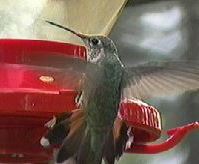
|
Rufous Hummingbird
Breeding in the pacific northwest from southern oregon all the way north to alaska, this is the northernmost breeding hummer in the world. their wintering grounds are still a bit of a mystery, as rufous are thought by some to keep moving along a huge migratory path throughout the non-breeding season. records of rufous from the eastern u.s. date back a century, but it seems that the rufous has become a regular winter resident of the southeast only within the past few decades, with perhaps a few hundred present at gardens and feeders each winter, mainly in the gulf states. rufous is by far the most likely hummer to be encountered in the southeast in winter. Rufous generally dominate feeders, often attacking anything that moves in their vicinity, even if it's clothes drying on a line. |
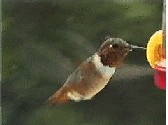
|
Allen's Hummingbird
Allen's Hummingbird is a very rare winterer in Louisiana, although the total number present in any given year is unknown due to their close
similarity to Rufous Hummingbird. Points of sexing young Rufous/Allen's hummers and of separating the two species are dealt with under the
account of Rufous, but to recap in short, the best diagnostic point in identifying Allen's is the shape and size of their tail feathers. Unfortunately
for field birders, measuring and noting these rectrices can only be done in hand, by licensed banders. Also, the size and shape of tail feathers varies
with age (immature vs. adult) and with sex. One possible point to look for in immature males, at least throughout mid-winter, is the presence of a rusty
patch on the sides of the face, including the lores and the area above the eye. This is illustrated below with in-hand photos (of two of the four immature
males banded so far in Lafayette) taken by bander Dave Patton. So far, all four young males banded in Lafayette have shown this feature. Certainly the
sample size is minute, and may reflect coincidence, but it might also be due to earlier or more complete molt of this area by Allen's. Immature male
Rufous often show rusty color on this same area, but in my experience never so completely as early as December. |
ORDER CORACIIFORMES
Family Alcedinidae: Kingfishers
| |
Belted Kingfisher |
| |
Ringed Kingfisher |
ORDER PICIFORMES
Family Picidae: Woodpeckers
| |
Red-Headed Woodpecker |
| |
Red-Bellied Woodpecker |
| |
Yellow-Bellied Sapsucker |
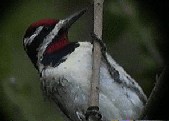
|
Red-Naped Sapsucker*
This bird, found on Feb. 22, 1994 at Acadiana Park, Lafayette, showed a deep red nape concolor with the crown and throat, with red flecks
scattered within the black of the border of the throat patch, and discrete white stripes on the back. This record is pending acceptance of the La.
Bird Records Comm. |
| |
Williamson's Sapsucker* |
| |
Downy Woodpecker |
| |
Hairy Woodpecker |
| |
Red-Cockaded Woodpecker |
| |
Northern Flicker |
| |
Pileated Woodpecker |